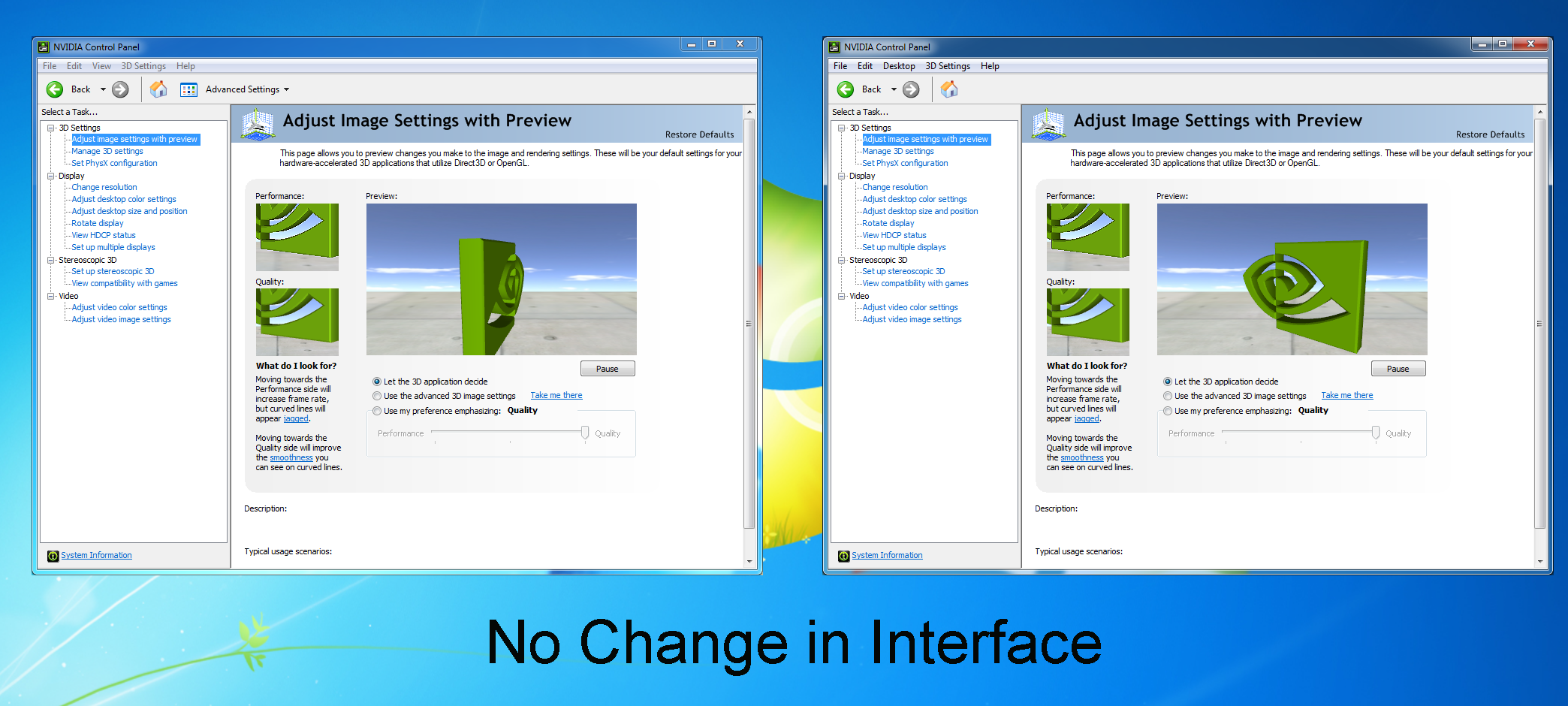Nvidia's GeForce GTX 480: Before And After A Year Of Driver Updates
Final Words
Unlike AMD's Catalyst drivers, we haven't seen a major overhaul of Nvidia's user interface within the past year. Performance, on the other hand, has definitely changed.
Over the course of almost 14 months, AMD's Catalyst drivers delivered 5% to 10% better performance. For Nvidia, the results are similar but the scale is larger. There are situations where we see little to no change in performance, but those scenarios are few in number. On average, we see a roughly 10% performance increase in as little as nine months.
| Driver | 197.41 | 257.21 | 260.89 | 266.58 |
|---|---|---|---|---|
| Date | 4/9/10 | 6/15/10 | 10/18/10 | 1/18/11 |
Some of our results are amazing. In Battlefield: Bad Company 2 and F1 2010, the minimum improvement is 30 percent. In one rare case, the GeForce GTX 480 experienced a 75% performance jump. The only oddball is World Of Warcraft: Cataclysm, where older drivers seem to deliver better performance. Practically speaking, the performance loss may not matter much. If you are already gaming at 90+ FPS in a MMORPG, losing nine FPS is probably inconsequential. But if you are spending hard-earned dough on a graphics card, it's in bad taste to lose performance in subsequent driver updates.
Nvidia proudly advertises how much performance you can gain with each driver release. This isn't without some fine print (literally). The company specifically cites the settings it uses to test, and smartly employs "up to" verbiage to indicate that your mileage may vary. As an example, for the GeForce GTX 480, only a few games in our suite are specifically expected to show improvement.
| Game (Setting) | Maximum Performance Gain from 197.41 to 266.58 (Per Nvidia) |
|---|---|
| Aliens vs. Predator (1920x1200, No AA/AF, Tessellation on) | 24.26% |
| Just Cause 2 (2560x1600, No AA/AF, Concrete Jungle) | 25% |
| Metro 2033 (1920x1200, No AA/16xAF, Tessellation on) | 7% |
| Aliens vs. Predator (1920x1200, 4xAA/16xAF, Tessellation on) | 11% |
| Metro 2033 (1920x1200, 4xAA/16xAF, Tessellation on) | 6% |
| Metro 2033 (1680x1050, No AA/16xAF, Tessellation on) | 7% |
| Battlefield: Bad Company 2 (1920x1200, 4xAA/16xAF) | 7% |
| Just Cause 2 (1920x1200, 4xAA/16xAF Dark Tower) | 5% |
Based upon these games and their settings, we can only say that Nvidia's claims of up to 25% improvement in Just Cause 2 at 2560x1600 seem a bit high, considering we only saw a 9% gain. And we assume the company made a typo, because the game's lowest AF setting is 2x.
Beyond performance gains, the conclusions from our earlier AMD driver article are still valid. We usually assume the largest performance jump occurs when we max out all settings, but this isn't true every time. The reverse actually occurred with Battlefield: Bad Company 2 and F1 2010. There are scenarios where new drivers bring better performance at lower resolutions and lower quality settings.
When it comes to the GeForce GTX 480 specifically, drivers seem to matter much more. This makes reasonable sense, given the newness of its Fermi architecture and the expected evolution that happens over time as driver developers and ISVs get more experience from the new hardware. You can look at this one of two ways. Either Nvidia is progressively optimizing its drivers or it did a poor job of delivering good performance when its card launched.
Get Tom's Hardware's best news and in-depth reviews, straight to your inbox.
The same can be said for AMD. It is either making fewer optimizations over time, or it is delivering more of its potential performance when a product launches. However, this only applies to the last generation of cards. It's possible that the scenario will change in the future when we look at the GTX 580 and the Radeon HD 6970.
Current page: Final Words
Prev Page Benchmark Results: World Of Warcraft: Cataclysm-
-Fran- Heh, now it cooks my steaks 5 secs faster.Reply
Oh wait... I'm using a GT425M on my notebook... Damn!
Cheers! -
dragonsqrrl Impressive results to say the least... well, except for WOW. That has to be a bit of a disappointment for the people who care about that title. But otherwise quite remarkable performance optimizations from the driver team.Reply
I have to agree with the conclusion, due to the recent nature of the Fermi architecture it probably took both Nvidia and developers time to get used to the new hardware. It just wasn't well optimized upon launch. Although I think it's worth noting that it still managed to perform well even on those early drivers. -
ezodagrom In the World of Warcraft page instead of saying "Percent Gain from 197.41 to 266.58" it says "Percent Gain from 9.10 to 11.1". ;PReply -
acku Reply9512364 said:In the World of Warcraft page instead of saying "Percent Gain from 197.41 to 266.58" it says "Percent Gain from 9.10 to 11.1". ;P
Oops! My motto: Pobody's Nerfect. :kaola:
Fixed! -
gofasterstripes TBH it looks like good work from the green team. Cool, my 470 is getting bumped for freeReply
On second thoughts, maybe 'cool' is the wrong word.....


